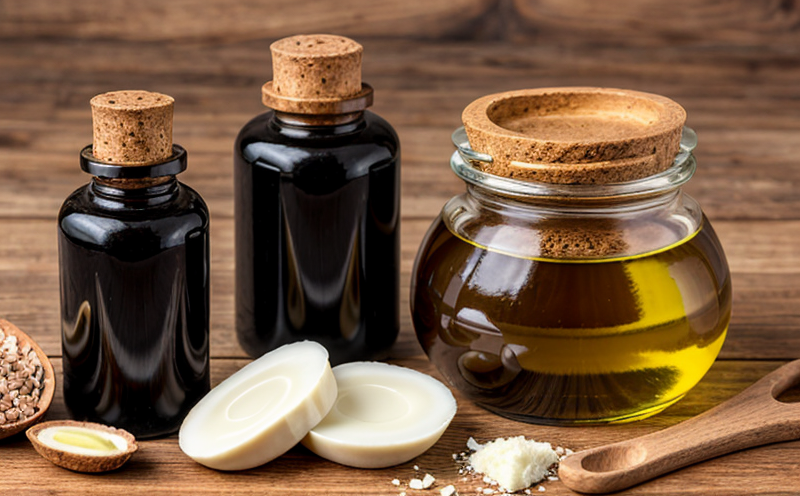Codex CAC/GL 70 Trace Metal Detection in Oils
The Codex CAC GL 70 standard provides a robust framework for the detection and quantification of trace metals in oils. This is crucial not only to ensure compliance with international regulations but also to maintain product safety and quality. Trace metal analysis helps in identifying potential contaminants that could affect human health or the environment, particularly those elements that are known to be toxic at even low concentrations.
The standard outlines detailed procedures for sample preparation, analytical methods, and reporting of results. Compliance with GL 70 is mandatory for international trade, especially when dealing with edible oils destined for consumption by humans. It ensures that the fats and oils meet safety thresholds as set forth in various regulatory frameworks such as the Codex Alimentarius Commission.
The testing process typically involves several steps including extraction of metals from the oil matrix using appropriate solvents or other methods, followed by instrumental analysis like inductively coupled plasma mass spectrometry (ICP-MS), atomic absorption spectroscopy (AAS), or flame photometric detection. These methods provide high sensitivity and specificity required for accurate quantification.
The key metals targeted under GL 70 include lead (Pb), cadmium (Cd), mercury (Hg), arsenic (As), copper (Cu), iron (Fe), manganese (Mn), nickel (Ni), zinc (Zn), molybdenum (Mo), and others. Each metal has its own significance depending on the type of oil being tested, processing methods used, and intended end use.
For instance, excessive levels of lead can be indicative of contamination from leaded gasoline or other industrial sources during extraction processes. Similarly, cadmium may suggest environmental pollution issues if present beyond acceptable limits. Monitoring these elements helps manufacturers maintain product integrity while meeting global standards for food safety.
The Codex GL 70 trace metal detection protocol is widely recognized and adopted by laboratories around the world due to its stringent requirements and comprehensive approach towards ensuring safe oils. It serves as a benchmark against which other national regulations are often aligned, making it an essential tool not just within industries but also for regulatory bodies responsible for overseeing food safety.
Compliance with GL 70 benefits both producers and consumers by fostering trust in the quality of traded goods while reducing risks associated with harmful contaminants. By adhering to this standard, companies demonstrate their commitment to maintaining high standards of hygiene and environmental responsibility throughout their supply chains.
Why It Matters
Ensuring compliance with Codex CAC/GL 70 is not just a legal requirement but also a critical component in safeguarding public health. Trace metals, especially those considered toxic at low concentrations like lead and cadmium, pose significant risks if present above permissible limits in oils used for human consumption.
- Lead: Known to cause neurological disorders, reproductive issues, and developmental delays, particularly in children.
- Cadmium: Linked to kidney damage, bone disease, and increased risk of cancer.
- Mercury: Associated with severe neurological effects including memory loss, tremors, and vision problems.
These metals can enter the food chain through various pathways, such as industrial emissions, agricultural practices, or improper waste disposal. By implementing strict trace metal detection protocols in accordance with GL 70, manufacturers can mitigate these risks effectively.
In addition to protecting consumer health, adhering to GL 70 also enhances brand reputation and market access opportunities internationally. Many countries have adopted Codex standards as their own legal requirements or guidelines for importing food products. Thus, compliance demonstrates a company's adherence to international best practices, boosting its credibility among both domestic and foreign markets.
Moreover, GL 70 supports sustainable development goals by promoting responsible production methods that minimize environmental impacts. By reducing contamination levels in processed oils, companies contribute positively towards achieving cleaner air and water resources.
Environmental and Sustainability Contributions
- Reduction of Pollution: Through rigorous trace metal detection, industries can identify sources of contamination early on and implement corrective measures to prevent further pollution.
- Incentive for Clean Production: Compliance with GL 70 encourages manufacturers to adopt cleaner production techniques that reduce the likelihood of introducing harmful metals into their products.
- Enhanced Resource Efficiency: By minimizing contamination, companies can use resources more efficiently without compromising product quality or safety.
The process of detecting trace metals also contributes indirectly to sustainability efforts by promoting transparency and accountability across supply chains. This fosters a culture where all stakeholders prioritize environmental responsibility.
Use Cases and Application Examples
| Scenario | Description |
|---|---|
| Industrial Waste Monitoring | Detecting trace metals in waste streams helps identify the source of contamination so that appropriate actions can be taken to prevent it from entering food processing facilities. |
| New Product Development | Testing raw materials for compliance ensures new products meet necessary safety standards before they reach consumers. |
| Supply Chain Verification | Regularly checking incoming shipments helps maintain consistent quality throughout the supply chain, thereby protecting both brand reputation and consumer health. |
| Batch Quality Control | Sampling during production allows manufacturers to monitor process efficiency and promptly address any issues that arise during manufacturing. |
| Post-Market Surveillance | Periodic checks on final products ensure long-term compliance with regulatory requirements, enhancing overall product safety. |
In practice, laboratories performing Codex GL 70 trace metal detection must be equipped with state-of-the-art instrumentation capable of detecting even minute amounts of metals. This includes advanced spectrometric equipment and reliable sample preparation techniques to ensure accurate results.
Real-world applications include monitoring palm oil mills for contamination from nearby mining operations, verifying the authenticity of olive oils against fake substitutes, ensuring the quality of sunflower seed oil used in cooking applications, among others. Each scenario highlights how this standard plays a vital role in maintaining product integrity and consumer trust across diverse markets.





